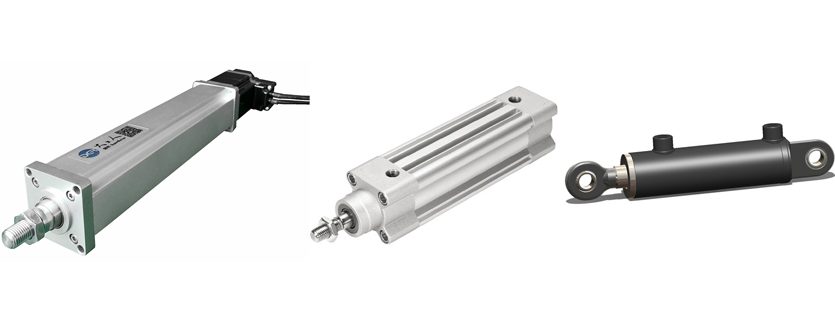Comprehensive comparison of electric cylinder, hydraulic cylinder and pneumatic cylinder
Linear actuators are mainly used for positioning, handling, clamping, and insertion of work pieces. They are widely used in various industries, such as: automated production lines, robotic arm industries; packaging machinery industry; automated furniture industry; CNC machine tools; press machines, etc.,
There are there kinds of linear actuators which are most often used, they are: electric cylinders, hydraulic cylinders, pneumatic cylinders, etc.
The following is a chart of comprehensive comparison on the advantages and drawbacks of electric cylinders, hydraulic cylinders and pneumatic cylinders from multiple aspects.
| Electric Cylinder | Hydraulic cylinder | Pneumatic cylinder | |
| Installation | All points are operated with simple wiring and are directly compatible with other electronic control components
| Need expensive pipes, filters, pumps, etc.
| Need expensive piping, filters, pumps, etc.
|
| Accuracy | Excellent positioning repeatability, ±0,013m, very stable, with a variety of stopping capabilities | Expensive positioning sensors and precision electro-hydraulic valves are required, with creeping trends
| Expensive positioning sensors and precision electro-hydraulic valves are required, with creeping trends
|
| Control | Directly compatible with standard programmable controllers, Automatically perform complex motion sequence operations | Electric or fluid interface required, hysteresis, dead zone, supply pressure and temperature changes complicate the control of the hydraulic cylinder
| Inherently non-linear control, compressible power supplies complicate servo control |
| Speed | Stable and adjustable speed, controlled acceleration between 0-2m/s
| Electric or fluid interface required, hysteresis, dead zone, supply pressure and temperature changes complicate the control of the hydraulic cylinder
| More susceptible to stick-slip and load, suitable for high-speed applications with light loads
|
| Reliability | Repeatable, reproducible performance over the entire service life of the product, requiring little maintenance.
| Very susceptible to contamination, requiring regular maintenance, seals prone to leaks, and its reliability requires frequent maintenance to ensure
| Very susceptible to contamination, air source requires proper filtration, high reliability but often requires the use of many system components
|
| Force | Up to 40000N
| Theoretically, power is unlimited
| Up to 25000N, usually used below 6000N |
| Service life | It can run millions of cycles under rated load, and its service life is very long
| Longer service life, depending on design and seal wear
| Longer service life, depending on design and seal wear
|
| Environment | Standard model rated temperature at -30 to +70 degrees Celsius, high efficiency and can clean itself
| The temperature limit is the main problem, seals are prone to leaks, waste disposal issues are more serious
| The temperature limit is the main problem, seals are prone to leaks, and the oil in the air can also cause problems.
|
| Sustained Load | The metric screw unit locks automatically in the event of a power failure and the product using a ball screw has a fail-safe brake
| Need to use complex anti-backlash safety devices
| Need to use complex anti-backlash safety devices
|
| Utilities | electric power only | Pump, power, pipes | Compressor, power, pipes |
| Efficiency | High | Low | Low |
| Noise | Low | High | High |
| Maintenance | Little to no maintenance except for when replacements are necessary | High user-maintenance though out the life of the system | High amount of maintenance |
| Purchase cost | High cost | High cost | Low cost |
| Operating cost | Low cost | High cost | Moderate cost |
| Maintenance cost | Low cost | High cost | Low cost |




Leave a Reply
Want to join the discussion?Feel free to contribute!